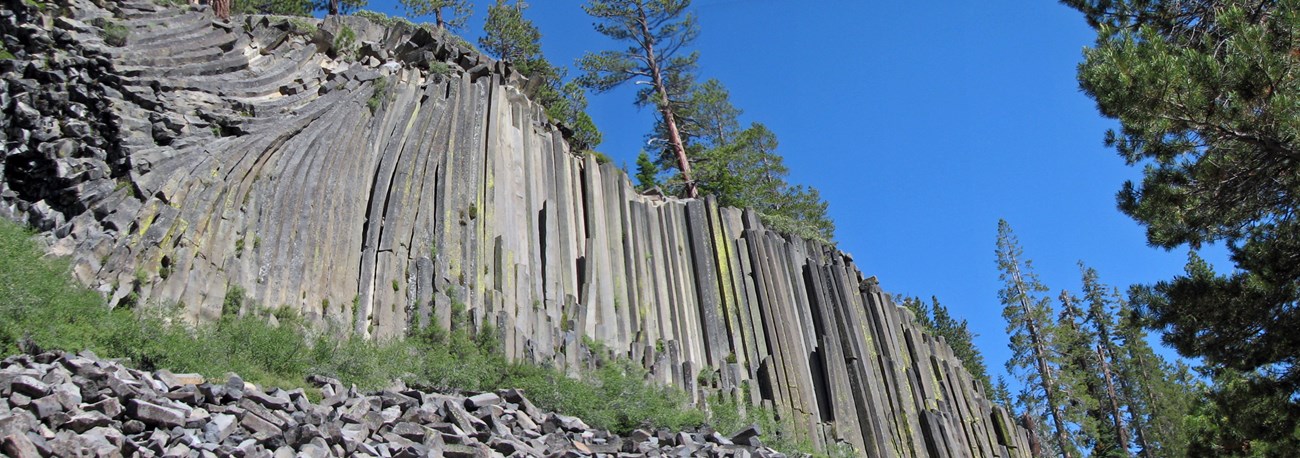
Photo by John St. James.
Introduction
Columnar jointing produces some of the most stunning scenic aspects of lava flows and other volcanic deposits found in national parks. Columnar jointing consists of sets of regularly spaced parallel fractures (joints) that intersect in a roughly prismatic pattern. Most columns are hexagonal, but they may have anywhere from three to seven sides.
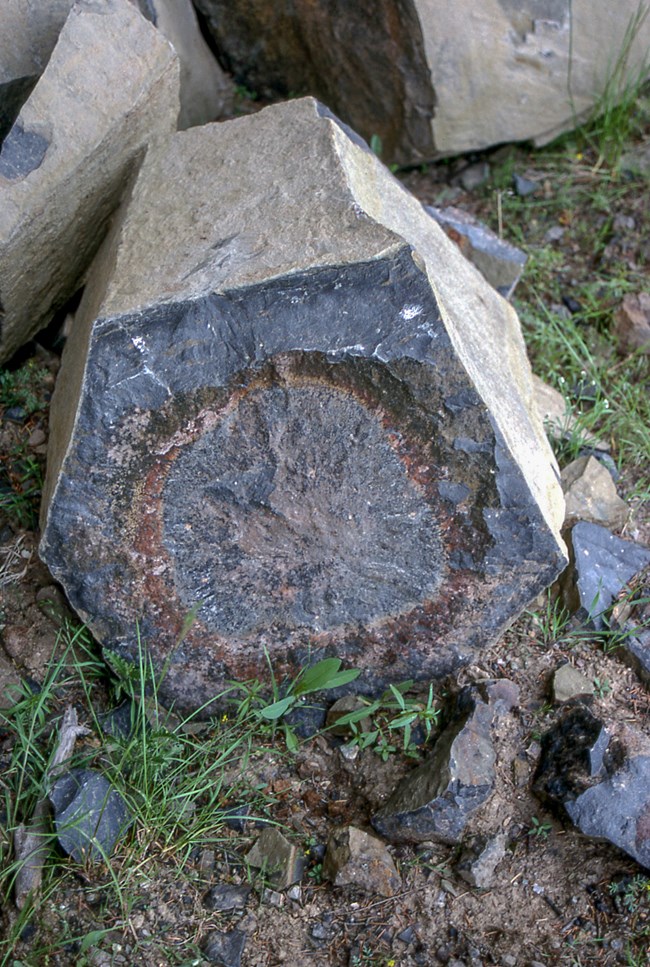
Columnar jointing is most commonly found in basaltic lava flows, but it also occurs in lava flows of other compositions, pyroclastic flow deposits (ignimbrites), in some lava domes, volcanic necks, and even in some shallow intrusions.
Devils Postpile National Monument and Devils Tower National Monument contain the best-known examples of columnar jointing in the United States. Devils Postpile NM in California was established primarily for the spectacular columnar jointed lava flow that makes up the heart of this small national monument. Erosion along columnar joints produces the nearly vertical columns that make Devils Tower in Wyoming so distinctive and compelling.
Photo 9right): Close up of columnar basalt at Overhanging Cliff.
Jim Peaco, June 1989.
How Columnar Jointing Forms
Columnar jointing is produced by cooling of lava flows, ash-flow tuffs, and other bodies of magma or lava. Cooling causes contraction which in turn causes fracturing. Fractures propagate from the top and bottom of flows inward towards the center.
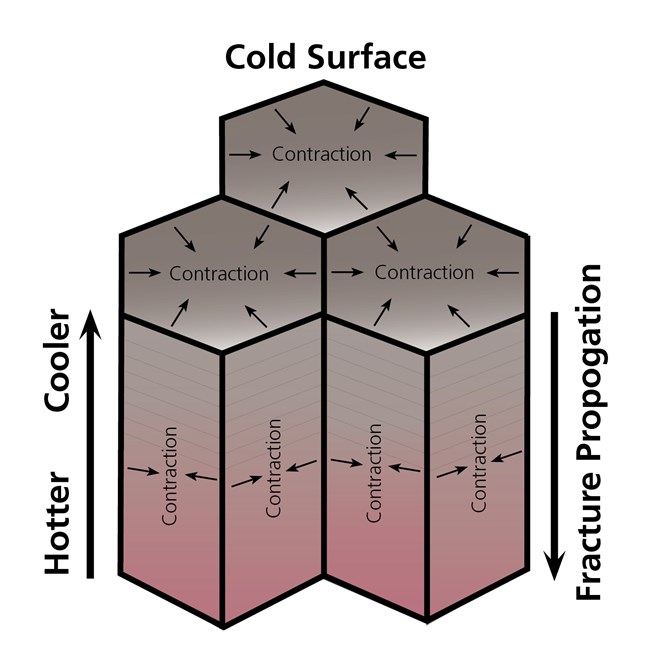
Graphic by Allyson Mathis.
The predominantly hexagonal pattern arises because contractional stress is most efficiently relieved by three fractures that intersect at angles of 120 degrees, which in turn creates six-sided polygons. Columns are oriented perpendicular to the main cooling surfaces of lava flows and other igneous bodies.
Columnar jointing forms after a lava flow or other igneous body has solidified, but while it is still at high to medium temperature. It is thought that columnar jointing forms during rapid cooling and that the development of the fracture system allows fluids to circulate which can further hasten the rate of cooling.
Some lava flows have irregular columnar jointing known as entablature, typically found in the interior portion or near the top of a flow. Some lava flows, particularly those that are part of the Columbia River Basalts may have a lower colonnade, the entablature, and an upper colonnade. The irregular fracturing of the entablature is likely due to a different cooling rate in the flow’s interior.
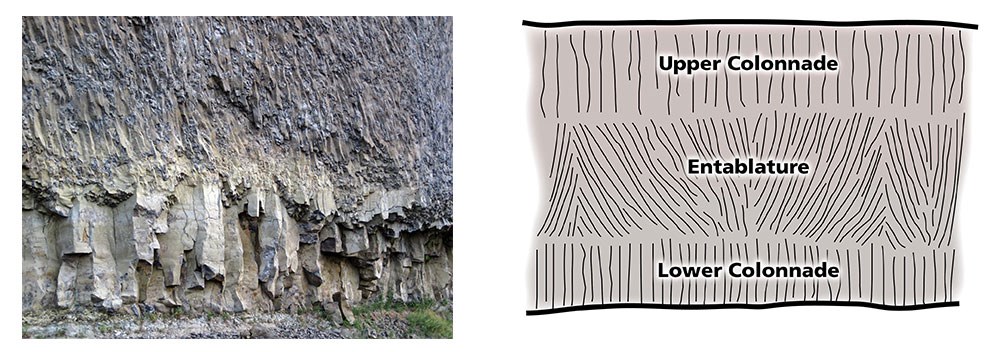
|
Photo (right): The entablature and lower colonnade of the Overhanging Basalt Lava Flow in Yellowstone National Park. |
Figure (left): The upper and lower colonnade and entablature of a lava flow. |
National Parks Columnar Jointing
At least 21 units of the National Park System contain lava flows or other igneous rocks displaying columnar jointing.
Devils Postpile National Monument
Devils Postpile contains columns up to 2.5 ft (1.1 m) in diameter that are up to 60 ft (18 m) long that are present in an exceptionally thick (up to 400 ft, 122 m) basalt flow that pooled after it erupted approximately 100,000 years ago.
Devils Postpile contains a high percentage (55%) of hexagonal columns. Some columns are curved and tilt away from the vertical suggesting that something may have impacted cooling rates and cooling surfaces in those areas.

NPS photo.
Related links
Devils Tower National Monument
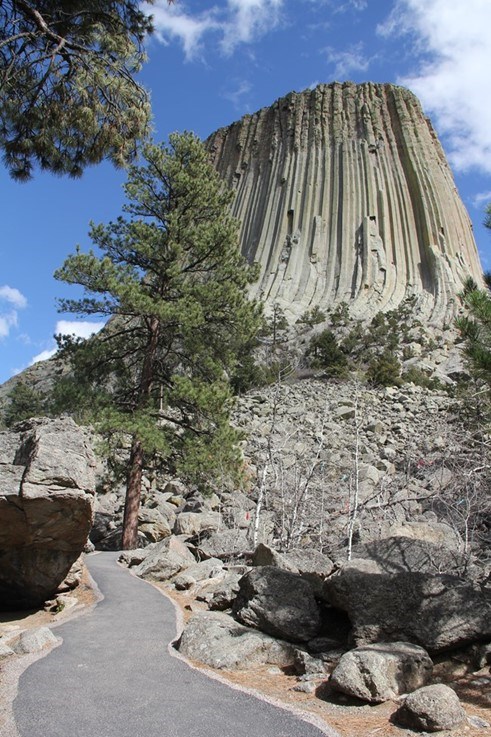
Devils Tower National Monument is also an iconic national park site featuring columnar jointing as a fundamental resource and value. Devils Tower formed about 40.5 million years ago, and may be a volcanic neck or a shallow intrusion. The spectacularly-developed columnar jointing is one of the most distinctive features of the tower. The larger columns are about 6-8 ft (1.8-2.4 m) diameter near the base and taper to about 4 ft (1.2 m) diameter at the top.
Photo (right): Talus from column collapse around the base of Devils Tower. The tower stands about 867 ft (264 m) tall.
NPS Photo.
Related Link
Fort Davis National Historic Site
Fort Davis in the Trans-Pecos region of Texas is surrounded by rhyolite cliffs displaying columnar jointing of the Sleeping Lion Formation. The Davis Mountains are notable for having large-volume rhyolitic lava flows and tuffs that have high concentrations of potassium and sodium that made them less viscous (e.g., more fluid) than most other rhyolites. The Sleeping Lion Formation was erupted about 36.5 million years ago.
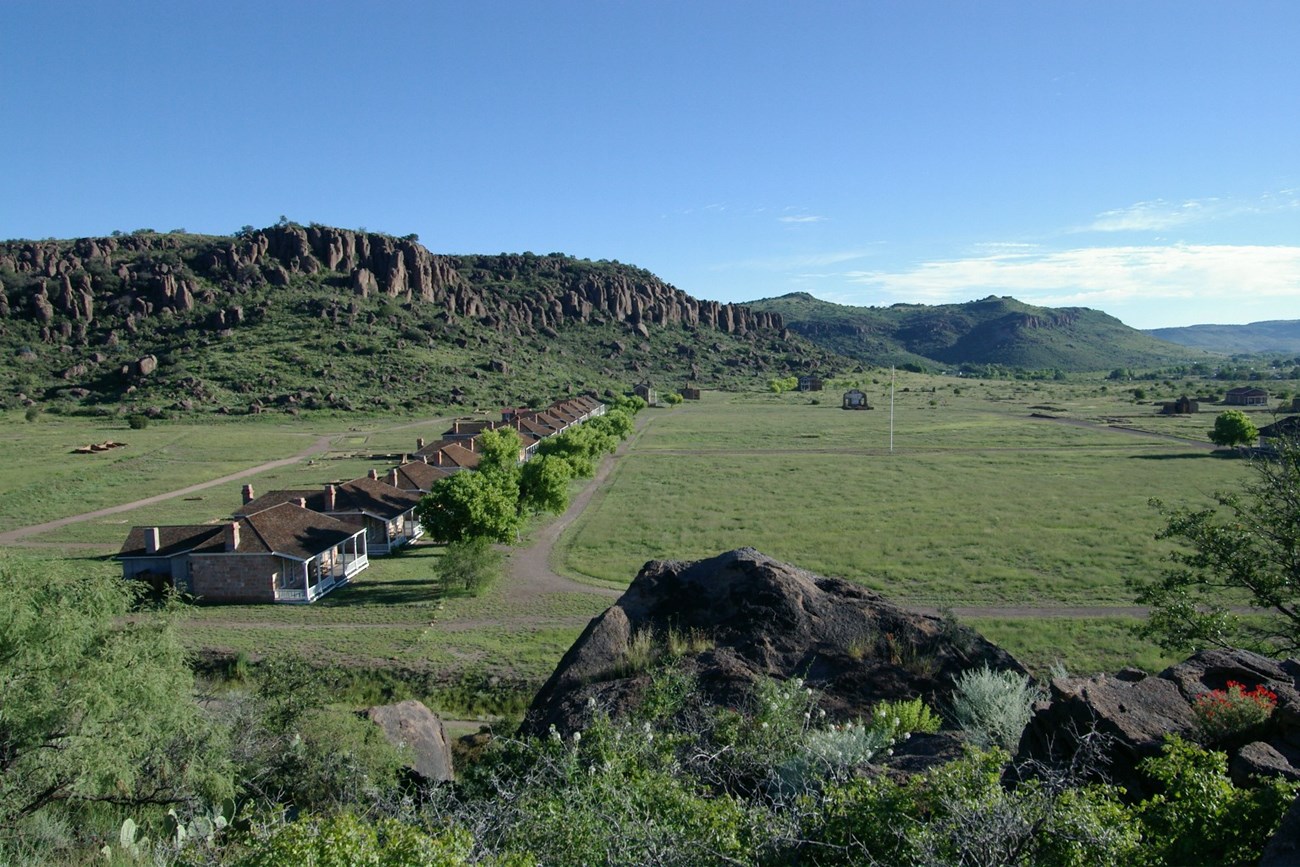
NPS photo.
Grand Canyon National Park
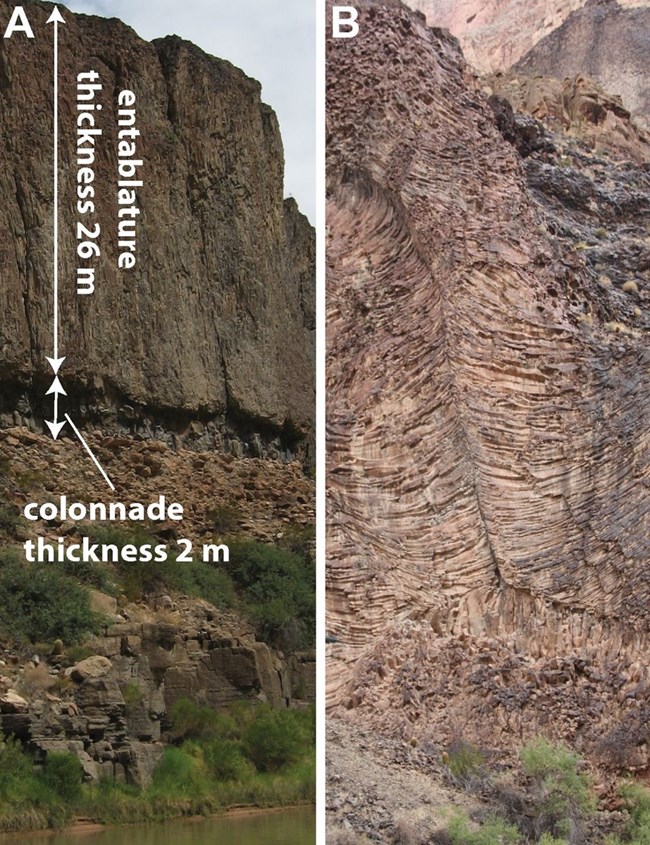
GRI figure from Crow, R. S., K. E. Karlstrom, W Mcintosh, L. Peters, L. Crossey, and A. Eyster. 2015. A new model for Quaternary lava dams in Grand Canyon based on 40Ar/39Ar dating, basalt geochemistry, and field mapping. Geosphere 11(5):1305–1342.
Basaltic lava flows poured into Grand Canyon between about 75,000 and 725,000 years ago. These flows traveled down the canyon and also built short-lived dams that blocked the Colorado River. Remnants of these lava flows and lava dams show various styles of columnar jointing.
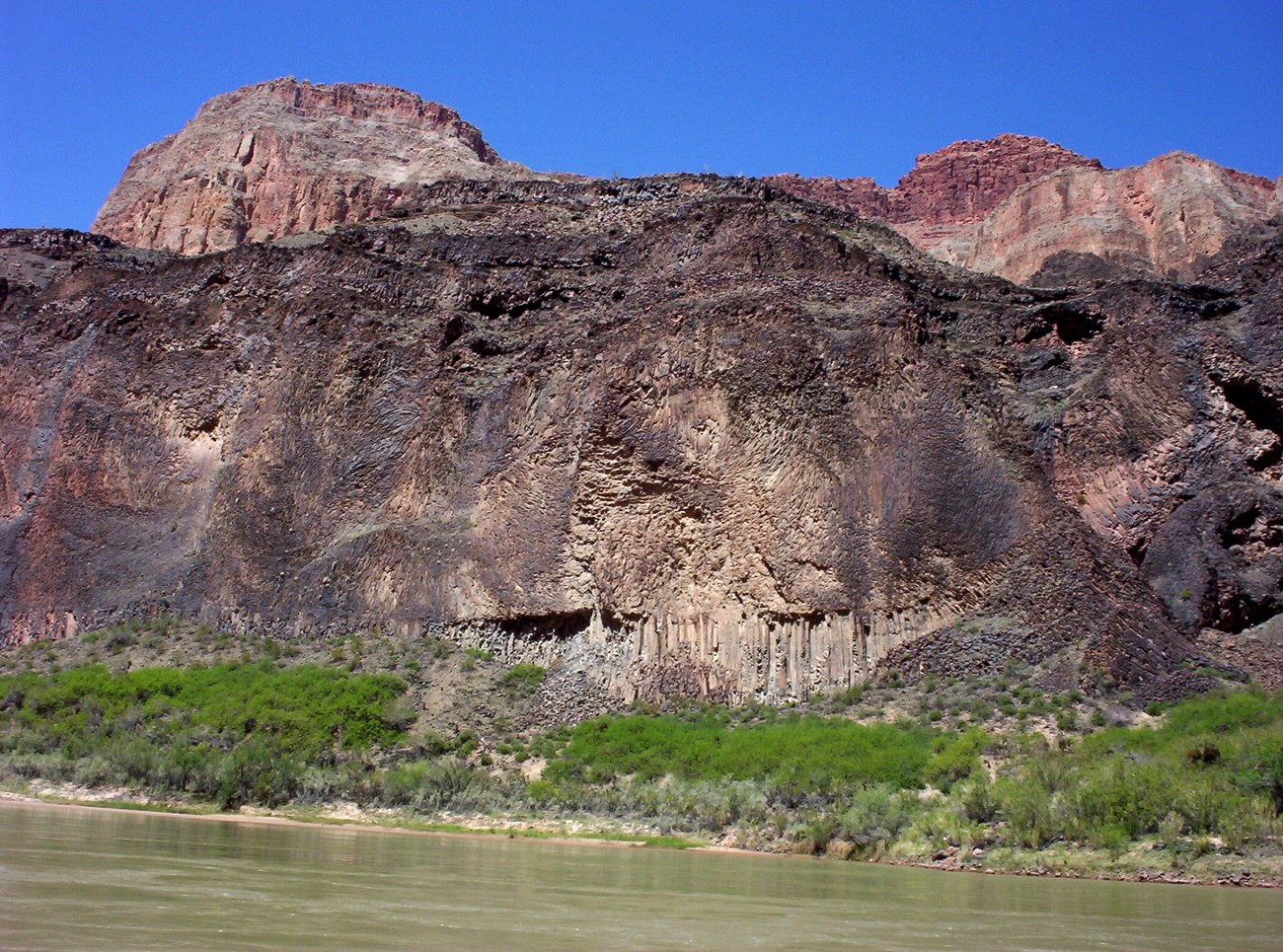
Photo by Allyson Mathis.
John Day Fossil Beds National Monument
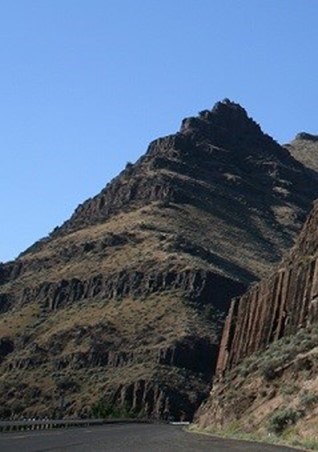
Columnar jointing is found in the Columbia River Basalts and Rattlesnake Tuff in and around John Day Fossil Beds National Monument. The Columbia River Basalts are flood basalts that were erupted from fissures in eastern Oregon, southeastern Washington, and Idaho, mostly between 16.7 and 15.5 million years ago. The Rattlesnake Ash-Flow Tuff is a large ignimbrite that erupted about 7 million years ago.
Photo (right): Columnar jointing in the Picture Gorge Basalts (a subgroup of the Columbia River Basalts) near the southern entrance to the Sheep Creek Unit of John Day Fossil Beds NM.
NPS photo.
Related Links
Lake Roosevelt National Recreation Area
Columbia River Basalts exposed in Lake Roosevelt NRA also exhibit well-developed columnar jointing.
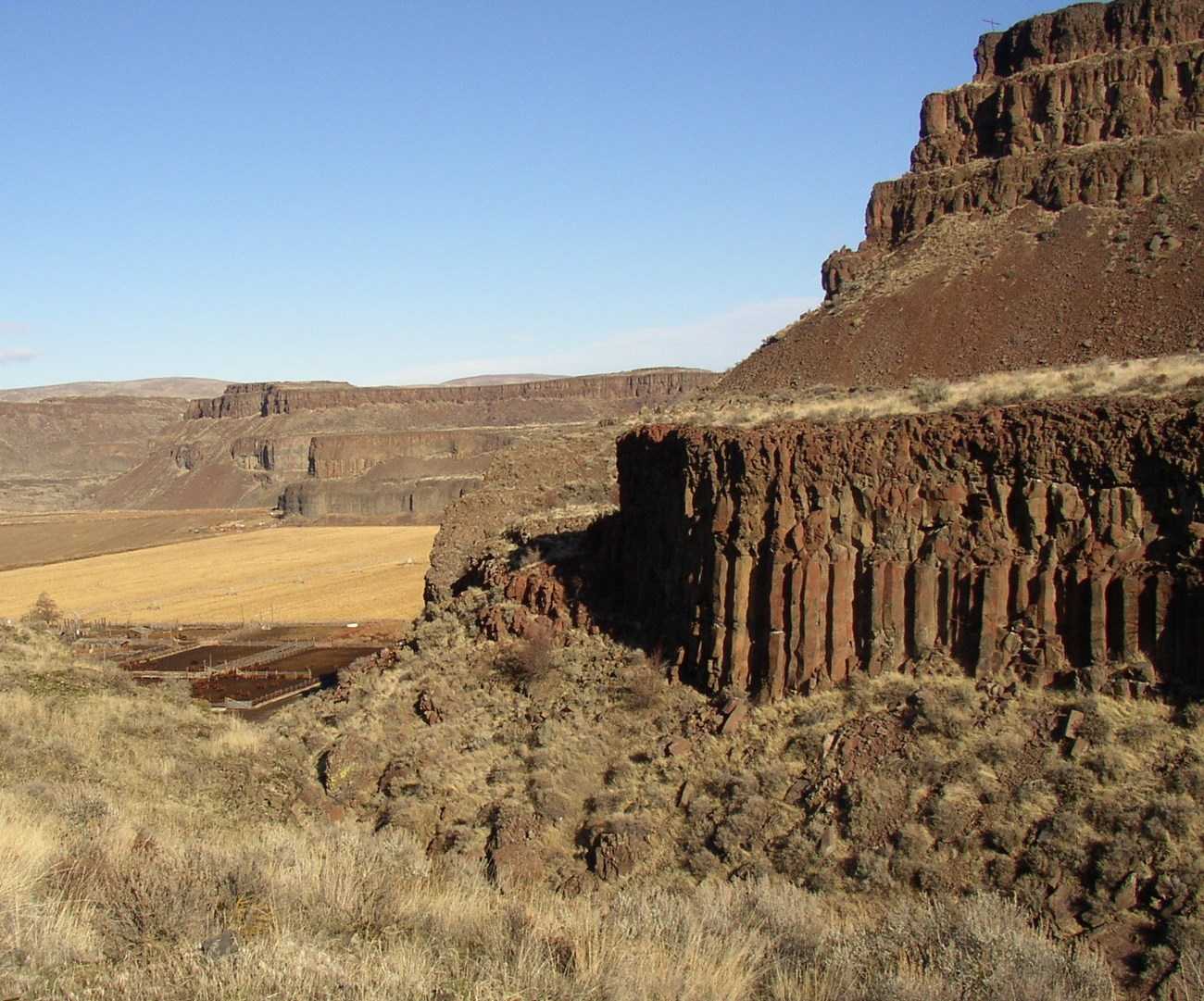
Related Link
Mount Rainier National Park
Columnar jointing is visible at a pullout along the road to Sunrise in Mount Rainier NP. These columns are in a lava flow that helps form Sunrise Ridge. It was erupted approximately 496,000 years ago.
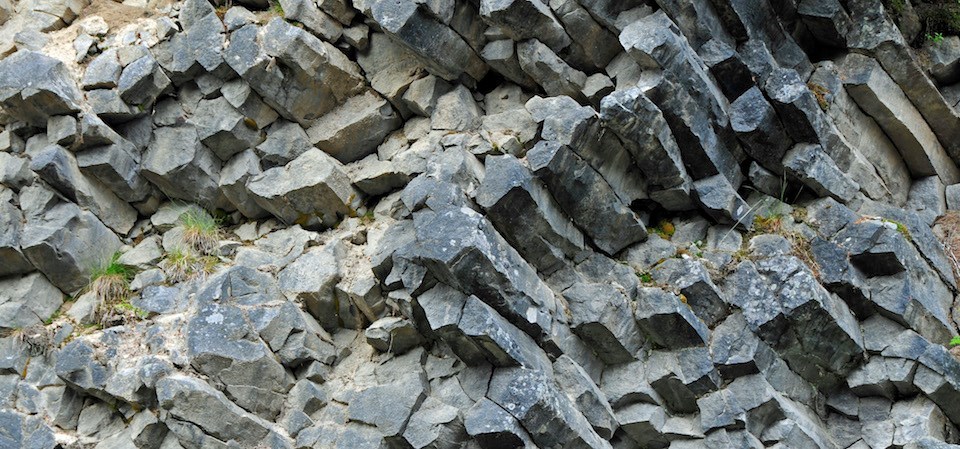
NPS photo.
Related links
Shenandoah National Park
Excellent examples of columnar jointing are found in Shenandoah National Park in Precambrian (approximately 570 million year old) greenstones. Greenstones are lightly metamorphosed basalt. These lavas were erupted from rift zones formed during the breakup of the Rodinia supercontinent.
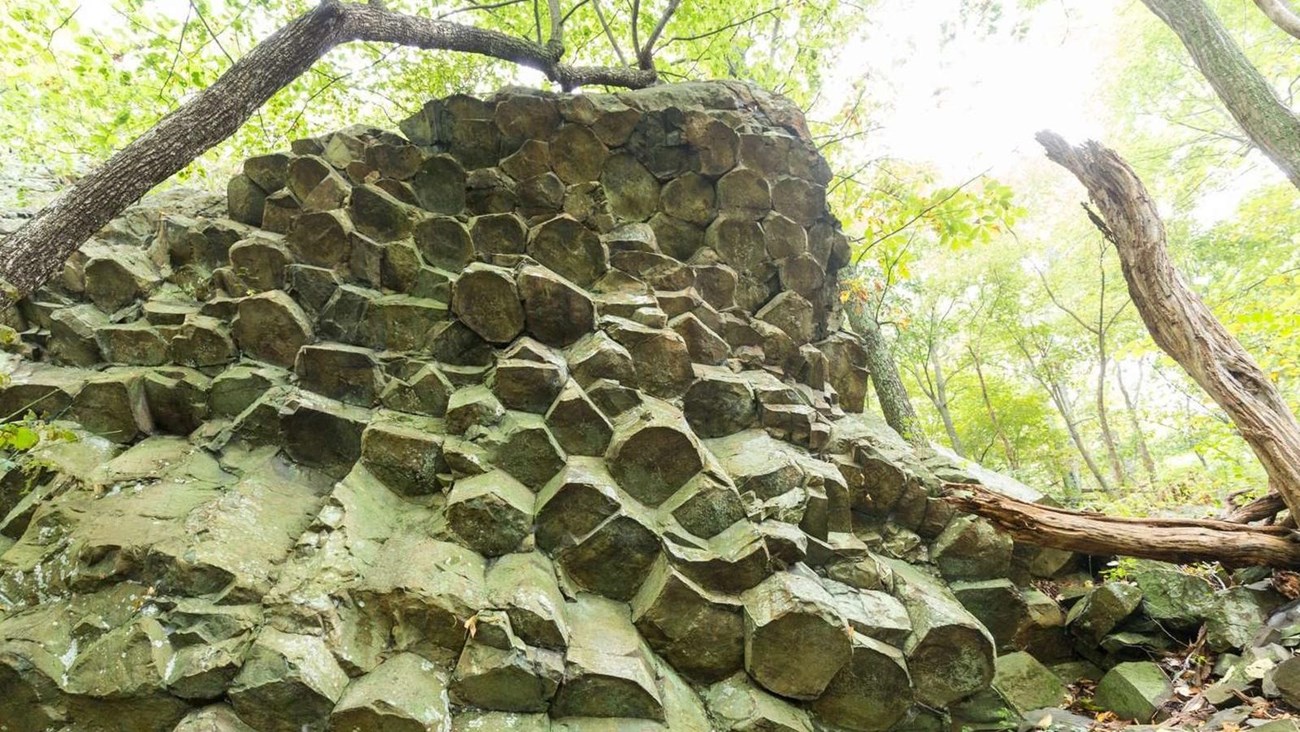
Related Links
Yellowstone National Park
Columnar jointing is found in both basaltic and rhyolitic lava flows in Yellowstone NP, including at famous locales such as Sheepeater Cliffs and Obsidian Cliff.
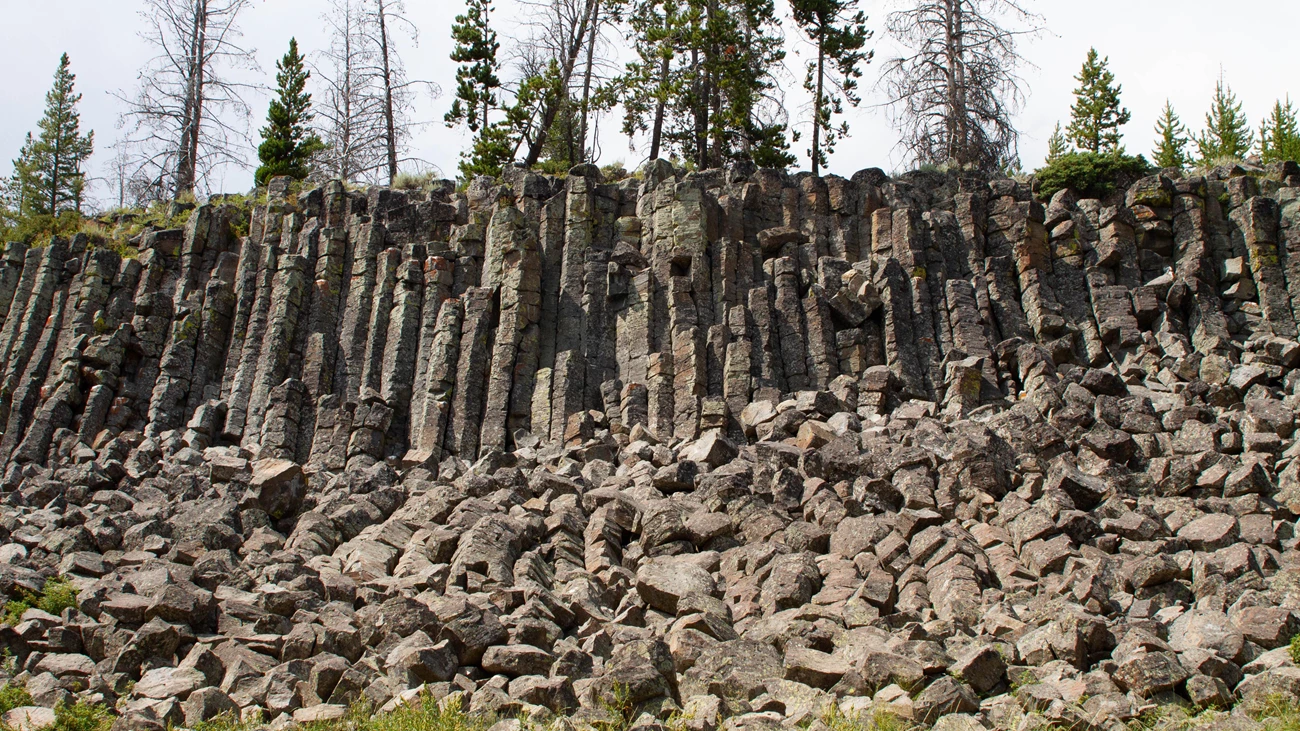
NPS photo by Diane Renkin.
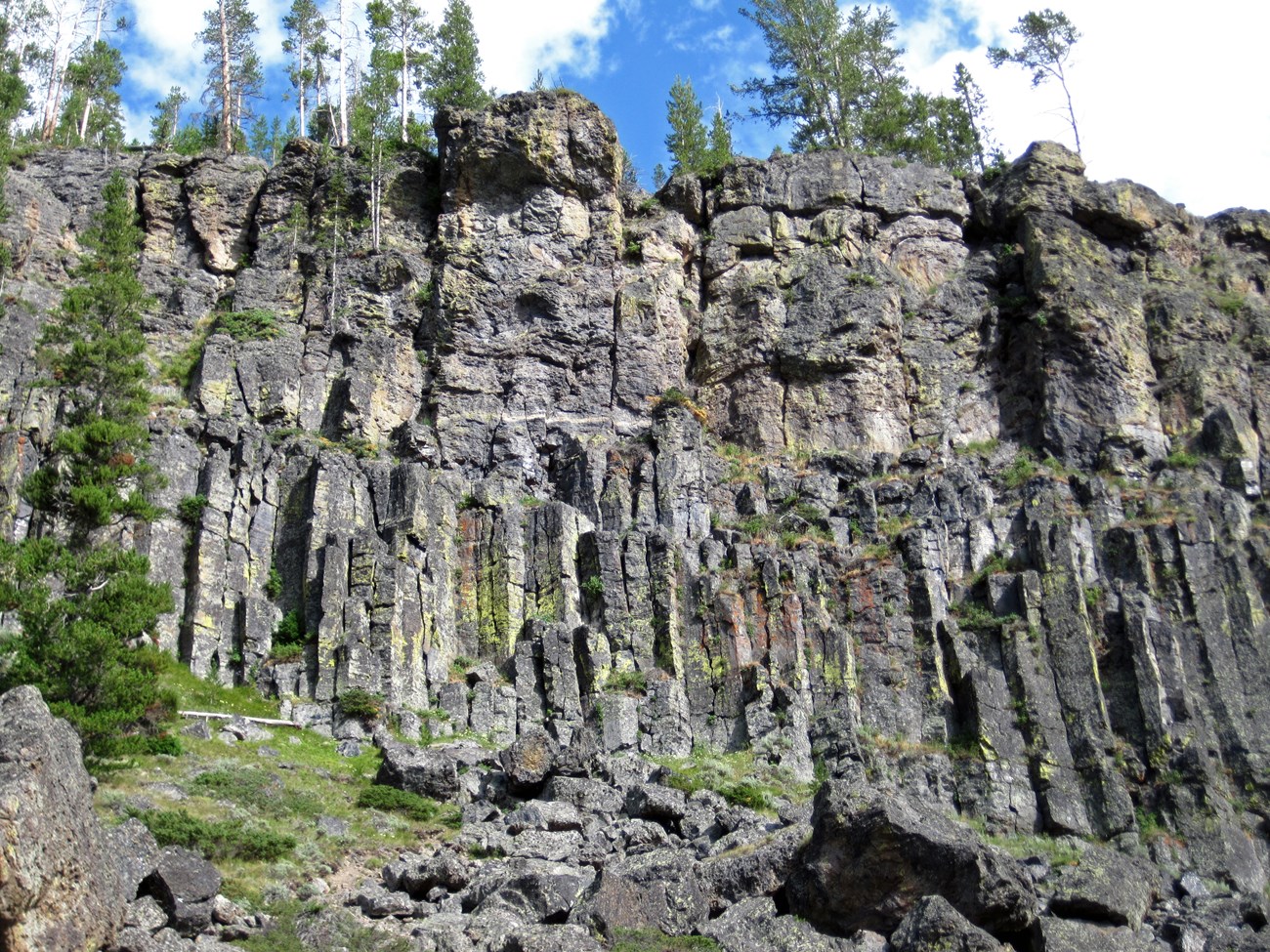
John St. James photo.
Related Link
Ice Age Floods National Historic Trail
The Bowl and Pitcher of Riverside State Park in Washington are made up of the Grand Ronde Basalt (part of the Columbia River Basalts) showing irregular entablature columnar jointing.
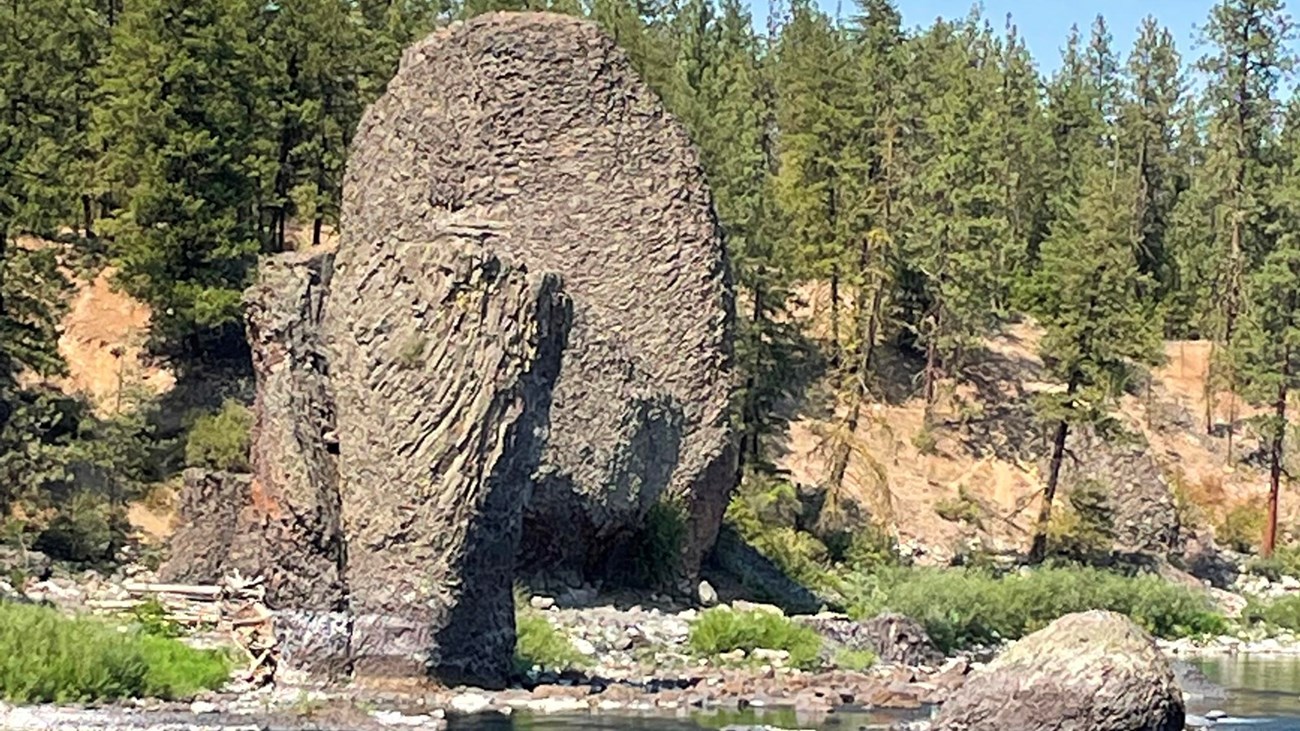
NPS photo by Justin Radford.
Related link
National Parks with Columnar Jointing
-
Bandelier National Monument (BAND), New Mexico—[BAND Geodiversity Atlas] [BAND Park Home] [BAND npshistory.com]
-
Big Bend National Park (BIBE), Texas—[BIBE Geodiversity Atlas] [BIBE Park Home] [BIBE npshistory.com]
-
Chiricahua National Monument (CHIR), Arizona—[CHIR Geodiversity Atlas] [CHIR Park Home] [CHIR npshistory.com]
-
Crater Lake National Park (CRLA), Oregon—[CRLA Geodiversity Atlas] [CRLA Park Home] [CRLA npshistory.com]
-
Devils Postpile National Monument (DEPO), California—[DEPO Geodiversity Atlas] [DEPO Park Home] [DEPO npshistory.com]
-
Devils Tower National Monument (DETO), Wyoming—[DETO Geodiversity Atlas] [DETO Park Home] [DETO npshistory.com]
-
Fort Davis National Historic Site (FODA), Texas—[FODA Geodiversity Atlas] [FODA Park Home] [FODA npshistory.com]
-
Grand Canyon National Park (GRCA), Arizona—[GRCA Geodiversity Atlas] [GRCA Park Home] [GRCA npshistory.com]
-
John Day Fossil Beds National Monument (JODA), Oregon—[JODA Geodiversity Atlas] [JODA Park Home] [JODA npshistory.com]
-
Katmai National Park (KATM), Alaska—[KATM Geodiversity Atlas] [KATM Park Home] [KATM npshistory.com]
-
Lake Roosevelt National Recreation Area (LARO), Washington—[LARO Geodiversity Atlas] [LARO Park Home] [LARO npshistory.com]
-
Lassen Volcanic National Park (LAVO), California—[LAVO Geodiversity Atlas] [LAVO Park Home] [LAVO npshistory.com]
-
Mount Rainier National Park, (MORA) Washington—[MORA Geodiversity Atlas] [MORA Park Home] [MORA npshistory.com]
-
Nez Perce National Historical Park (NEPE), ID, OR, MT, WA—[NEPE Geodiversity Atlas] [NEPE Park Home] [NEPE npshistory.com]
-
Petrified Forest National Park (PEFO), Arizona—[PEFO Geodiversity Atlas] [PEFO Park Home] [PEFO npshistory.com]
-
Petroglyph National Monument (PETR), New Mexico—[PETR Geodiversity Atlas] [PETR Park Home] [PETR npshistory.com]
-
Saguaro National Park (SAGU), Arizona—[SAGU Geodiversity Atlas] [SAGU Park Home] [SAGU npshistory.com]
-
Shenandoah National Park (SHEN), Virginia—[SHEN Geodiversity Atlas] [SHEN Park Home] [SHEN npshistory.com]
-
Wrangell-St. Elias National Park and Preserve (WRST), Alaska—[WRST Geodiversity Atlas] [WRST Park Home] [WRST npshistory.com]
-
Yellowstone National Park (YELL), Wyoming—[YELL Geodiversity Atlas] [YELL Park Home] [YELL npshistory.com]
-
Yosemite National Park (YOSE), California—[YOSE Geodiversity Atlas] [YOSE Park Home] [YOSE npshistory.com]
Photo Album
Examples From Around the National Park System
Last updated: April 18, 2023
